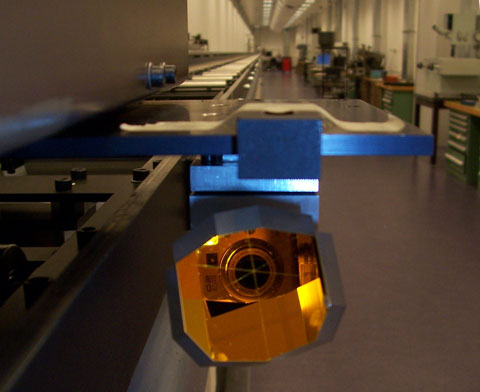Previously Dr Bas Swinkels had developed laser metrology in the same group with a different kind of laser. A new ‘femtosecond laser’ was expected to perform even better, producing ultra-short pulses of light (40 microns long) separated by 15 centimetres of nothing. Distance can be measured by splitting the laser beam: one part is sent down the distance to be measured, gets reflected and then returns; the other part bounces on a moveable reflector situated nearby. A pulse counter provides an estimate of (twice) the distance in multiples of 15 centimetres. Overlaying the pulses from both arms and bringing them into interference was expected to lower the precision to the order of the light wavelength (0.4 micron).
However, air plays funny tricks on laser pulses. The pulses that had travelled 100 meters through air were deformed beyond recognition. “Temperature, pressure and humidity influence the refractive index, which is slightly different for each of the 18,000 frequencies that constitute the laser pulse,” Bhattacharya explains.
By calculating the exact influence of air on the pulses, Cui succeeded in restoring the interference between the pulses from both arms, thus attaining an accuracy of 1 to 2 micron in measuring a distance of 50 metres. A world record, says his co-supervisor.
The developed technology might have unexpected applications. Although laser metrology was developed for the fine positioning of satellites in space, the knowledge of the refractive index of air might now also be used for terrestrial laser metrology over distances of kilometres, or for the optical analysis of breath gases. Drunk drivers beware.
Moxi Cui, ‘Distance Metrology in Air with a Femtosecond Frequency Comb Laser’, 11 October 2010, PhD supervisor Prof. Paul Urbach.
L&R had in Roderik Koenders (26) de beste afstudeerder. “Voor mijn afstudeeropdracht heb ik in samenwerking met ESA/Estec onderzoek gedaan naar het proces voor landingsplaatsselectie voor de nieuwe ExoMarslander naar Mars. Deze missie gaat op zoek naar sporen van fossiel en mogelijk bestaand leven en dan willen we niet in de Sahara maar in het Amazonegebied van Mars landen. Momenteel wordt de landingsplaats geselecteerd in een proces waar wetenschappers stemmen op de beste landingsplaatsen en waar na jaren overleg een mogelijke plek wordt gekozen. Wat ik wilde doen is of we het proces konden omkeren door te kijken wat wetenschappers nu eigenlijk willen ontdekken op Mars en dan te zoeken naar veilige plekken op Mars welke hier aan voldoen.



Comments are closed.